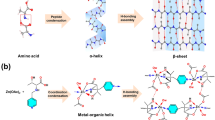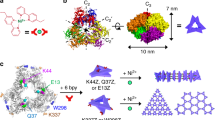Abstract
Chirality at the supramolecular level involves the non-symmetric arrangement of molecular components in a non-covalent assembly1,2. Supramolecular chirality is abundant in biology, for example in the DNA double helix3, the triple helix of collagen4 and the α-helical coiled coil of myosin5. These structures are stabilized by inter-strand hydrogen bonds, and their handedness is determined by the configuration of chiral centres in the nucleotide or peptide backbone. Synthetic hydrogen-bonded assemblies have been reported that display supramolecular chirality in solution6,7,8 or in the solid state9,10,11,12. Complete asymmetric induction of supramolecular chirality—the formation of assemblies of a single handedness—has been widely studied in polymeric superstructures13,14. It has so far been achieved in inorganic metal-coordinated systems15,16,17, but not in organic hydrogen-bonded assemblies18,19,20. Here we describe the diastereoselective assembly of enantio-pure calix[4]arene dimelamines and 5,5-diethylbarbituric acid (DEB) into chiral hydrogen-bonded structures of one handedness. The system displays complete enantioselective self-resolution: the mixing of homomeric assemblies (composed of homochiral units) with opposite handedness does not lead to the formation of heteromeric assemblies. The non-covalent character of the chiral assemblies, the structural simplicity of the constituent building blocks and the ability to control the assembly process by means of peripheral chiral centres makes this system promising for the development of a wide range of homochiral supramolecular materials or enantioselective catalysts.
This is a preview of subscription content, access via your institution
Access options
Subscribe to this journal
Receive 51 print issues and online access
$199.00 per year
only $3.90 per issue
Buy this article
- Purchase on Springer Link
- Instant access to full article PDF
Prices may be subject to local taxes which are calculated during checkout






Similar content being viewed by others
References
Havinga, E. Spontaneous formation of optically active substances. Biochim. Biophys. Acta 13, 171–174 (1954).
Lehn, J.-M. Supramolecular Chemistry, Concepts and Perspectives(VCH, Weinheim, (1995).
Dickerson, R. E. et al. The anatomy of A-, B-, and Z-DNA. Science 216, 475–485 (1982).
Okuyama, K., Okuyama, K., Arnott, S., Takanyanagi, M. & Kakudo, M. Crystal and molecular structure of a collagen-like polypeptide (Pro-Pro-Gly)10. J. Mol. Biol. 152, 427–443 (1981).
Warrick, H. M. & Spudich, J. A. Myosin: structure and function in cell motility. Annu. Rev. Cell Biol. 3, 379–422 (1987).
Seto, C. T. & Whitesides, G. M. Molecular self-assembly through hydrogen bonding: supramolecular aggregates based on the cyanuric acid.melamine lattice. J. Am. Chem. Soc. 115, 905–916 (1993).
Ghadiri, M. R., Granja, J. R., Milligan, R. A., McRee, D. E. & Khazanovich, N. Self-assembling organic nanotubes based on a cyclic peptide architecture. Nature 366, 324–327 (1993).
Conn, M. M. & Rebek, J. J Self-assembling capsules. Chem. Rev. 97, 1647–1668 (1997).
Geib, S. J., Vincent, C., Fan, E. & Hamilton, A. D. Aself-assembling, hydrogen-bonded helix. Angew. Chem. Int. Edn Engl. 32, 119–121 (1993).
Hanessian, S., Gomtsyan, A., Simard, M. & Roelens, S. Molecular recognition and self-assembly by “weak” hydrogen bonding: unprecedented supramolecular helicate structures from diamine/diol motifs. J. Am. Chem. Soc. 116, 4495–4496 (1994).
Saurez, M., Branda, N., Lehn, J.-M., De Cian, A. & Fischer, J. Supramolecular chirality: chiral hydrogen-bonded supermolecules from achiral molecular components. Helv. Chim. Acta 81, 1–13 (1998).
Atwood, J. L. & MacGillivray, L. R. Achiral spherical molecular assembly held together by 60 hydrogen bonds. Nature 389, 469–472 (1997).
Rowan, A. E. & Nolte, R. J. M. Helical molecular programming. Angew. Chem. Int. Edn Engl. 37, 63–68 (1998).
Palmans, A. R. A., Vekemans, J. A. J. M., Havinga, E. E. & Meijer, E. W. Sergeants-and-soldiers principle in chiral columnar stacks of disc-shaped molecules with C3symmetry. Angew. Chem. Int. Edn Engl. 36, 2648–2651 (1997).
Zarges, W., Hall, J., Lehn, J.-M. & Bolm, C. Helicity induction in helicate self-organisation from chiral tris(bipyridine) ligand strands. Helv. Chim. Acta 74, 1843–1852 (1991).
Woods, C. R., Benaglia, M., Cozzi, F. & Siegel, J. S. Enantioselective synthesis of copper(I) bipyridine based helicates by chiral templating of secondary structure: transmission of stereochemistry on the nanometer scale. Angew. Chem. Int. Edn Engl. 35, 1830–1833 (1996).
Mamula, O., Von Zelewsky, A. & Bernardinelli, G. Completely stereospecific self-assembly of a circular helicate. Angew. Chem. Int. Edn Engl. 37, 289–293 (1998).
Castellano, R. K., Kim, B. H. & Rebek, J. J Chiral capsules: asymmetric binding in calixarene-based dimers. J. Am. Chem. Soc. 119, 12671–12672 (1997).
Qiao, S., Choi, I. S. & Whitesides, G. M. Observation of diastereomers of the hydrogen-bonded aggregate Hub(M)3.3CA using 1H NMR spectroscopy when CA is an optically-active isocyanuric acid. J. Org. Chem. 62, 2619–2621 (1997).
Rivera, J. M., Martin, T. & Rebek, J. J Chiral spaces: dissymmetric capsules through self-assembly. Science 279, 1021–1023 (1998).
Vreekamp, R. H., Van Duynhoven, J. P. M., Hubert, M., Verboom, W. & Reinhoudt, D. N. Molecular boxes based on calix[4]arene double rosettes. Angew. Chem. Int. Edn Engl. 35, 1215–1218 (1996).
Timmerman, P. et al. Noncovalent assembly of functional groups on calix[4]arene molecular boxes. Chem. Eur. J. 3, 1823–1832 (1997).
Crego Calama, M., Fokkens, R., Nibbering, N. M. M., Timmerman, P. & Reinhoudt, D. N. Libraries of non-covalent hydrogen bonded assemblies; combinatorial synthesis of supramolecular systems. Chem. Commun. 1021–1022 (1998).
Green, M. M. et al. Ahelical polymer with a cooperative response to chiral information. Science 268, 1860–1866 (1995).
Russell, K. C., Lehn, J.-M., Kyritsakas, N., DeCian, A. & Fischer, J. Self-assembly of hydrogen-bonded supramolecular strands from complementary melamine and barbiturate components with chiral selection. New J. Chem. 22, 123–128 (1998).
Gulik-Krzywicki, T., Fouquey, C. & Lehn, J.-M. Electron microscopic study of supramolecular liquid crystalline polymers formed by molecular recognition-directed self-assembly from complementary chiral components. Proc. Natl Acad. Sci. USA 90, 163–167 (1993).
Prelog, V. & Helmchen, G. Basis of the CIP system and proposal for a revision. Angew. Chem. Int. Edn Engl. 21, 567–594 (1982).
Jolliffe, K. A. et al. Characterization of supramolecular hydrogen-bonded assemblies by MALDI-TOF mass spectrometry after Ag+-labelling. Angew. Chem. Int. Edn Engl. 37, 1294–1297 (1998).
Acknowledgements
We thank R. Hulst for the 2D ROESY experiments, R. Fokkens and N. M. M. Nibbering for the MALDI-TOF measurements, and E. W. Meijer for providing the use of the CD equipment. This work was supported by the Council for Chemical Sciences (CW) and the Technology Foundation (STW) of the Netherlands Organization for Scientific Research (NWO).
Author information
Authors and Affiliations
Corresponding author
Supplementary information
Rights and permissions
About this article
Cite this article
Prins, L., Huskens, J., de Jong, F. et al. Complete asymmetric induction of supramolecular chirality in a hydrogen-bonded assembly. Nature 398, 498–502 (1999). https://doi.org/10.1038/19053
Received:
Accepted:
Issue Date:
DOI: https://doi.org/10.1038/19053
This article is cited by
-
Chiral transcription in self-assembled tetrahedral Eu4L6 chiral cages displaying sizable circularly polarized luminescence
Nature Communications (2017)
-
Chirality- and sequence-selective successive self-sorting via specific homo- and complementary-duplex formations
Nature Communications (2015)
-
Inversion of Supramolecular Chirality by Sonication-Induced Organogelation
Scientific Reports (2015)
-
A dynamic supramolecular polymer with stimuli-responsive handedness for in situ probing of enzymatic ATP hydrolysis
Nature Communications (2014)
-
Calix[n]imidazolium as a new class of positively charged homo-calix compounds
Nature Communications (2013)
Comments
By submitting a comment you agree to abide by our Terms and Community Guidelines. If you find something abusive or that does not comply with our terms or guidelines please flag it as inappropriate.



